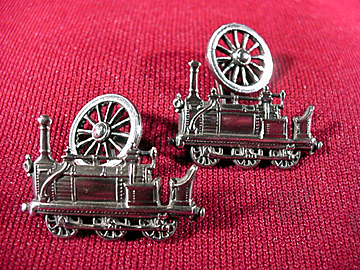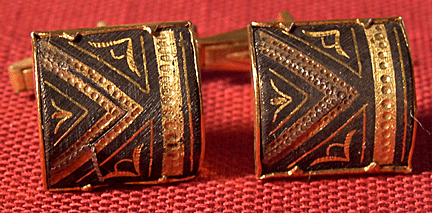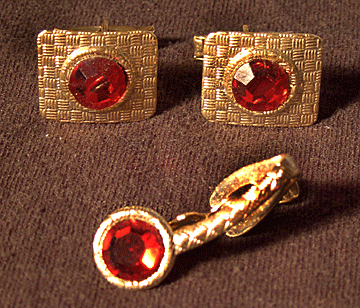 As one of the few accepted items in a limited line of men’s jewelry, cuff
links get a man noticed. When a woman says, "I love your cuff
links," she means I'm impressed and want to talk to him more. When she
says, "What interesting cuff links," she' means I'm not sure if I
like them but he might be worth further investigation. When she says,
"'They're very different," she means I hate them and I want this
conversation to be as short as possible. But when she says, "I suppose
you chose them yourself," she means he’s got bad taste and should be
arrested by the taste police. As one of the few accepted items in a limited line of men’s jewelry, cuff
links get a man noticed. When a woman says, "I love your cuff
links," she means I'm impressed and want to talk to him more. When she
says, "What interesting cuff links," she' means I'm not sure if I
like them but he might be worth further investigation. When she says,
"'They're very different," she means I hate them and I want this
conversation to be as short as possible. But when she says, "I suppose
you chose them yourself," she means he’s got bad taste and should be
arrested by the taste police.
No other collectible causes such an array of reactions.
And this is precisely why so many people collect cuff links. Other reasons
are their relatively inexpensive cost, easy storage, and availability. A
search through virtually any antiquing spot attests to the seemingly endless
styles, shapes and designs produced in the last 200 years.
Egyptian hieroglyphics contain evidence that as far back
as King Tut’s dynasty, people were using decorative cuff-linking devices.
Over the centuries cuff links have maintained this important dual role as
both practical fasteners, and fashion accessories.
The earliest cuff links date from the same period as the
cuff-fastening slit. Handmade of various metals, usually gold and silver,
and set with gemstones, they became a luxury for the wealthy. Typically, a
wire loop, a flat, curb chain or string fastened them together. The term
"cuff link" was first found in print 100 years later in 1788.
Removable buttons date back to the early 18th century. In
the early 19th century when buttons became mass-produced and
cheap enough to sew onto the material itself, these studs, with rounded
shanks on the back that looked like flat metal buttons, became used only at
the cuffs, so people referred to them as "cuff buttons." On the
other hand, those same mass production techniques meant that the variety of
cuff links increased dramatically.
 The French or double-cuff shirtsleeve also became a
popular fashion accessory in the 1840s after the publication of Alexander
Dumas’ novel The Three Musketeers stimulated this new touch in
fashion. After 1840, cuff links were affordable." Victorian lucky
charms, hearts, flowers, love birds, ivy, love knots, angels, snakes, even
babies found their way to cuff links of the era. The French or double-cuff shirtsleeve also became a
popular fashion accessory in the 1840s after the publication of Alexander
Dumas’ novel The Three Musketeers stimulated this new touch in
fashion. After 1840, cuff links were affordable." Victorian lucky
charms, hearts, flowers, love birds, ivy, love knots, angels, snakes, even
babies found their way to cuff links of the era.
The English middle class adopted cuff links during the
reign of George IV, toward the end of the Industrial Revolution. Unable to
afford gemstones, they turned to replicas of the real thing. Designers used
"rhinestones" and pastes to represent diamonds, pinchbeck, a
copper and zinc alloy, as a substitute for gold, and cut steel and marcasite
as a substitute for silver.
During the late Georgian and Victorian periods, cuff link
makers used foil or paste, a type of leaded glass, for backings. While
country folk enjoyed simple designs, city folk chose more elaborate and
decorative ones. Dandies like Beau Brummel and Lord Byron set the fashions,
and amazingly elaborate and gaudy cuff links became fashionable in London.
This was an era of decoration. Most cuff links sported embroidery, precious
metals, painted designs and in some cases, huge paste or real gems.
Cufflink makers during the Art Nouveau period embraced
free-flowing whiplash lines, organic motifs and stunning, romantic feminine
figures and faces cast in gold--either gold filled or plated, between 10 and
18 karat. By then, cuff links could be purchased with shirt studs or stick
pins as a set.
 Manufacturers of the 1950s arid 60's frequently marketed
cuff links in a series--pairs featuring cars, sports themes, etc. Also
popular, were various caricature cuff links, images of sports, political and
theatrical celebrities. One interesting category of cuff link, the "do-ers,"
are cuff links that do something in addition to fastening, such as nail
clippers, thermometers, watches. Manufacturers of the 1950s arid 60's frequently marketed
cuff links in a series--pairs featuring cars, sports themes, etc. Also
popular, were various caricature cuff links, images of sports, political and
theatrical celebrities. One interesting category of cuff link, the "do-ers,"
are cuff links that do something in addition to fastening, such as nail
clippers, thermometers, watches.
Early cufflink makers used either gold or silver, and
sometimes copper to produce their wares. Men favored enameled cuff links during the late Georgian
period (1820-1830), but it was during the Art Deco period that enamels
reached their peak of popularity. Craftsmen mixed powdered glass with
distilled water to form a wet paste, then spread it into depressions in the
cuff link’s backing. After the paste dried, they’d bake it at 1600
degrees to fuse it together, finally polishing it to a high luster. Because
each color required a separate firing, the process was delicate and time
consuming.
Craftsmen employed a variety of techniques for creating
depressions in the cufflink’s metal backing. They used
cloisonné,
outlining the designs on the base with fine silver wire or applied it at
varying heights and depths known as basse taille. The Victorians
perfected champlevé, a competing process. In this latter technique
the craftsman incised, etched, engraved, or chiseled a pattern into the
metal. In general, more metal is seen in champleve’; more enamel in
cloisonné and basse taille.
Reverse intaglio was a popular way of embellishing 19th
century cuff links. After carving a figure or scene in great detail into the
back of a cabochon crystal, an artisan would carefully fill in the work with
paint and apply a mother of pearl backing.
Some cuff links collectors build their collections around
the different fasteners. Since the early 1940's, the most popular fastener
has been the "American Toggle," the type most commonly seen on
today’s cuff links.
 Mid-Georgian cuff link makers used the dumbbell fastener.
They carved it from a piece of ivory in the early part of the 19th century
and by mid-century, from a pearl. Carved dumbbells had a slightly curved
shank, looking like exercise weights whose ends were too heavy for the bar.
Dumbbells of glass, coral, gold, gold plate and various hard stones became
fashionable by the 1890s. Late Georgian cuff link makers employed wire
loops, curb chains and string as fasteners. During the last quarter of the 19th century, cufflink
artisans crafted seven new types of fasteners or linkages with another five
designs tentatively attributed to the period. That’s a new fastener every
two years! A metal button fastener, circa 1880, looked like an
oversized shirt stud. The center-hinged fastener, circa 1880, looked like
two pair of miniature ice tongs welded together at the handles. Both sides
of the cufflink rotated around the points of the ice tongs or center hinge.
Three spring steel fasteners came into fashion in the
1885-1888 period--the turret, loop and finger prongs. Mid-Georgian cuff link makers used the dumbbell fastener.
They carved it from a piece of ivory in the early part of the 19th century
and by mid-century, from a pearl. Carved dumbbells had a slightly curved
shank, looking like exercise weights whose ends were too heavy for the bar.
Dumbbells of glass, coral, gold, gold plate and various hard stones became
fashionable by the 1890s. Late Georgian cuff link makers employed wire
loops, curb chains and string as fasteners. During the last quarter of the 19th century, cufflink
artisans crafted seven new types of fasteners or linkages with another five
designs tentatively attributed to the period. That’s a new fastener every
two years! A metal button fastener, circa 1880, looked like an
oversized shirt stud. The center-hinged fastener, circa 1880, looked like
two pair of miniature ice tongs welded together at the handles. Both sides
of the cufflink rotated around the points of the ice tongs or center hinge.
Three spring steel fasteners came into fashion in the
1885-1888 period--the turret, loop and finger prongs.
 Among the fasteners attributed to the late 19th century
was the post-fastener, a simple, straight forward design which resembled a
shirt stud. Both sides of the post-fastener were essentially the same size
with a short, solid connector between them. The S-wire fastener, attributed
to 1895, was designed so that the inside and outside faces mounted at the
top and bottom of a stylized letter S. In 1895, cuff link makers introduced
the ball fastener, a metal variation of the carved dumbbell but with a
straight shank. Among the fasteners attributed to the late 19th century
was the post-fastener, a simple, straight forward design which resembled a
shirt stud. Both sides of the post-fastener were essentially the same size
with a short, solid connector between them. The S-wire fastener, attributed
to 1895, was designed so that the inside and outside faces mounted at the
top and bottom of a stylized letter S. In 1895, cuff link makers introduced
the ball fastener, a metal variation of the carved dumbbell but with a
straight shank.
The double stirrup fastener featured two stirrups pivoted
together to insert the link through the sleeve slot and then snapped out to
hold the link in place. A wishbone fastener, a device which may have been
introduced in 1899, looked and functioned like a large paper clip. The thin,
wiry device was used with a wristband, not a fold-over French cuff. Another,
the "one-piece link" from the 1890s, continues to be produced
today. It has a metal face, slightly curved fastening device and a metal
oval to hold it fast to the inside of the cuff.
< Back to
Antiques Articles
Go to the next antiques article > |
